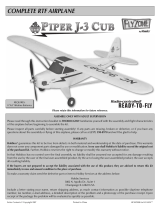1. Find an open area free of buildings, trees, power
lines and people.
2. For your first few flights, fly only when the wind is
calm. After you are comfortable with the airplane, you
can fly in winds that are no more than 5 miles per hour.
If flown in stronger winds, the plane may be blown
down wind and not have enough power to get back.
3. Make sure the battery pack is fully charged and
that the transmitter has fresh “AA” batteries installed.
4. If others are flying in the same area, make sure that
they are not using the same channel radio system you
are. The front of your transmitter has a tag with a number
on it (i.e. channel 50, 72.790). This is the channel
number and frequency you are using. If someone is on
the same channel or frequency, DO NOT switch on
your transmitter until they are finished flying.
Your transmitter controls the altitude, direction, roll
and speed of the airplane. The left stick controls the
speed and direction and the right stick controls the
altitude and roll.
When the battery power gets too low, the “Auto Cut-
Off” feature of the speed control provides an extra
degree of insurance. It reacts to low power by pulsing
the motor on and off, in effect saving power for the
receiver. That way your airplane goes into a glide and
you stay in control as you land.
If you have never flown an R/C airplane before, we
recommend that you get help from an experienced
R/C pilot. Most R/C clubs have training programs that
will help you learn to fly quickly. If you cannot find
an experienced pilot to help you learn, the following
will help you get your airplane into the air.
1. First switch your transmitter power switch “ON.”
Be sure your left control stick on the transmitter is all
the way down.
2. Now pick up the airplane and switch the airplane
on. Caution: Keep your hands behind the propeller.
3. Arm the motor by moving the left control stick all the
way up. Hold the throttle lever here for the count of 5.
Then, move the stick back down. Now when the stick
is moved up, the propeller will start to turn. The farther
the stick is moved, the faster the propeller will turn.
4. Range check your radio before each flight. Switch on
the transmitter and then switch on the airplane. Have a
helper hold the airplane. With the transmitter antenna
collapsed, walk 100 feet away from the airplane,
holding the transmitter with the antenna pointing up.
Move the control sticks, checking that the control
surface responds. Also, turn the motor on and check
the range. If you still have control of the airplane, it is
safe to extend the transmitter antenna and fly the
airplane. If you do not have control of the plane, make
sure the batteries in the transmitter are fresh and the
battery in the plane is charged. Also, make sure the
wire antenna is extending out the back of the airplane.
5. With the throttle stick moved fully up, hand launch
the Cessna 182 Skylane into the wind, at a slight
upward angle. Note: For the first couple of flights, we
recommend having a helper hand launch the
airplane. After you become familiar with the flight
characteristics of the airplane, it can be flown off a
hard surface instead of hand launched.
6. Pull the right stick toward you so that the plane
climbs at a 20 to 30 degree angle. Allow the airplane
to climb a few seconds before turning it.
7. When your airplane is moving away from you,
moving the right stick (ailerons) to the left, combined
with a small amount of up elevator (moving the right
stick down), will make your plane turn to the left.
Moving the stick to the right with a small amount of up
elevator will make the airplane turn to the right. To stop
the turn, move the stick the opposite direction until the
airplane is flying level and return the elevator to center.
Caution: It only requires a small amount of up elevator.
FLYING THE CESSNA 182 SKYLANE
PREPARE FOR TAKEOFF
11























